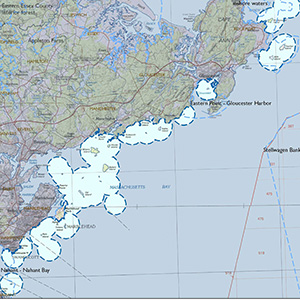Important Bird Area Sites in Massachusetts
Important Bird Area: Essex County Coastal Bird Islands
Site Summary
Nominated By
Chris Leahy
Size
c. 250-300 acres
Towns and Counties
Gloucester, Manchester, Marblehead, Nahant, Rockport, Salem; Essex
Ownership
MassWildlife, US Fish & Wildlife Service, municipal, private, Mass Audubon, The Trustees Of Reservation
Major Habitats
oak-conifer transitional forest, early successional shrubland, cultural grassland, emergent freshwater wetland, coastal beach, marine/tidal
Land Use
nature & wildlife, conservation/land trust, hunting/fishing, other recreation or tourism, agriculture/livestock, military, undeveloped, aquaculture (proposed)
Serious Threats
introduced animals or feral pets, succession, disturbance to birds or habitat
IBA Criteria
- Category 2: Single-species Concentrations: The site regularly supports significant concentrations of a flocking species, but may not meet the thresholds above. The site should support a higher proportion of a species' statewide population (more than 1%, if known) than other similar sites.
Site Description
The rocky coastline from Nahant to Cape Ann is dotted with granite skerries lying less than a mile from shore. This IBA contains all of those islands that contain populations of seabirds and/or wading birds. The individual islands vary greatly in their ornithological significance, some containing a few pairs of gulls or cormorants, while one, Kettle Island, is the single most important wading bird breeding site in Massachusetts.
Current Conservation Status
Factors that are most likely to adversely affect the present situation are human disturbance (the surrounding waters are increasing popular for recreational boating and fishing and many of the landings are not difficult in good weather) and habitat change. The latter could occur through private development, succession of native or non-native vegetation, or through the degradation of the habitat by the birds themselves, which is typical of wading bird colonies. The concentration of so many state rare species at a single site is a major concern since one incident could cause abandonment of the entire colony, and it is not clear whether satisfactory alternative sites exist on other islands. Ideally, all of these islands should be monitored at least annually, and certain management initiatives (such as eradication of rats and gulls) should be considered. Thriving rat populations may inhibit colonization of many of these islands by species such as the Common Eider; coyotes are very common on the mainland of Essex County, and the swim to Kettle Island is short. Presently, the only conservation actions that occur on these islands is annual monitoring of populations on Kettle (and occasionally other islands) by Mass Audubon and censuses of all of the other islands by the Division of Fisheries and Wildlife at 10-year intervals. Mass Audubon is currently proposing a comprehensive ecological survey of these islands.
Ornithological Significance
Category 1. Two of the species presently nesting, the Little Blue Heron and Tricolored Heron, now nest only at this site, with total populations much lower than for many state listed species. The same can be said for the tiny population (2 pairs) of Cattle Egrets that nest on Eagle Island. One or more pairs of Arctic Terns has purportedly bred at Tinkers Island in the past.
Category 2. Snowy Egrets and Black-crowned Night-Herons nest on Kettle Island, and the latter nests on Coney, Thatcher, and Eagle islands.
Category 3a. The population of breeding gulls for all of the islands is estimated at 6,367 pairs. These islands hold 30 percent of the state's Double-crested Cormorant population, with two of them (Milk and Egg Rock) accounting for 20 percent of the state total; Milk Island holds the second largest Double-crested Cormorant colony in the Commonwealth. Common Eiders appear to have bred (females with downy young) in recent years on Straitsmouth, Ten Pound Island, and Norman's Woe, and Black Guillemots nest in the Isles of Shoals just over the Massachusetts border in New Hampshire.
Category 3b. Kettle Island contains the single most important wading bird breeding colony in Massachusetts, with Tricolored and Little Blue Herons nesting nowhere else and major populations of Great and Snowy Egrets and Glossy Ibises. This is now the northernmost extremity of the range of the Tricolored Heron. Eagle Island is the only breeding site for Cattle Egret in Massachusetts.
Category 3g. The following species meet this criterion both considering the aggregate populations of the islands and for some individual islands: Double-crested Cormorant, Great Egret, Snowy Egret, Little Blue Heron, Tricolored Heron, Black-crowned Night-Heron, and Glossy Ibis. Great Cormorants have been present all summer long on Cape Ann for a number of years, and juvenal birds were present in late summer in 2001; it would not be surprising to confirm nesting of this species within this IBA in the near future.
Category 3f. There are anecdotal accounts of large land bird migrant "fall outs" on these island; in most cases birds resting and feeding on the islands would be relatively undisturbed.
Category 4. It is possible to argue that the fact that these sites are islands (relatively isolated and mainly undisturbed) by itself meets the criterion of "unique habitat."
Other Flora or Fauna of Significance
None known
Data Sources
Annual Census of Kettle Island by Massachusetts Audubon Society
Blodget, B.G. 1994-1995. Massachusetts Coastal Colonial Waterbird Inventory. MassWildlife, Westborough, MA.
Veit, R.R., and W.R. Petersen. 1993. Birds of Massachusetts. Massachusetts Audubon Society, Lincoln, MA.




